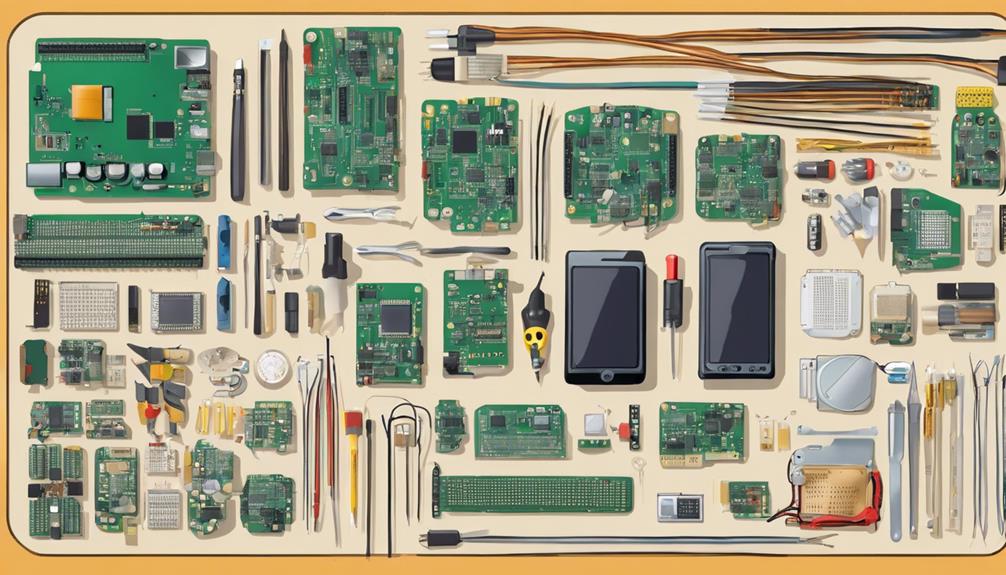Securing quality in PCB assembly demands a multifaceted approach that encompasses meticulous material selection, precise equipment calibration, and stringent quality control measures to prevent defects and ensure reliability. A thorough assembly line checklist is essential to identify defects early, reduce errors, and improve product quality. This involves developing a quality control checklist that covers dimensional accuracy, visual inspections, and functional testing. By implementing quality control measures, manufacturers can enhance product reliability, customer satisfaction, and brand reputation. Additionally, refining processes and evaluating quality metrics can further optimize production and enhance quality assurance, leading to a more efficient and effective assembly line operation.
Key Takeaways
- Develop a quality control checklist to ensure dimensional accuracy, visual inspections, functional testing, and cleanliness control.
- Implement stringent quality control measures throughout the PCB assembly line to prevent defects and ensure product reliability.
- Conduct regular inspections and testing to identify defects early, reducing waste and improving customer satisfaction.
- Establish quality standards based on regulations and customer expectations, and train staff on quality control procedures for consistency.
- Continuously monitor and evaluate quality control measures to optimize the process and improve product quality.
Understanding PCB Assembly Process
Accurate control of the PCB assembly process is essential, as it directly impacts the performance, reliability, and overall quality of the final electronic device. In the domain of electronics manufacturing, precision and accuracy are paramount to guaranteeing high-quality standards.
The PCB assembly process involves soldering electronic components onto printed circuit boards (PCBs) using surface mount technology (SMT) and through-hole technology (THT) for smaller and larger components, respectively. To maintain quality control, manufacturers must focus on solder joint quality, component placement accuracy, and overall electronics functionality.
Any deviations from these standards can compromise the reliability and performance of the final product. By understanding the intricacies of the PCB assembly process, manufacturers can implement quality control measures that guarantee precision and accuracy, ultimately resulting in high-quality electronic devices that meet the desired specifications.
Developing Quality Control Checklist
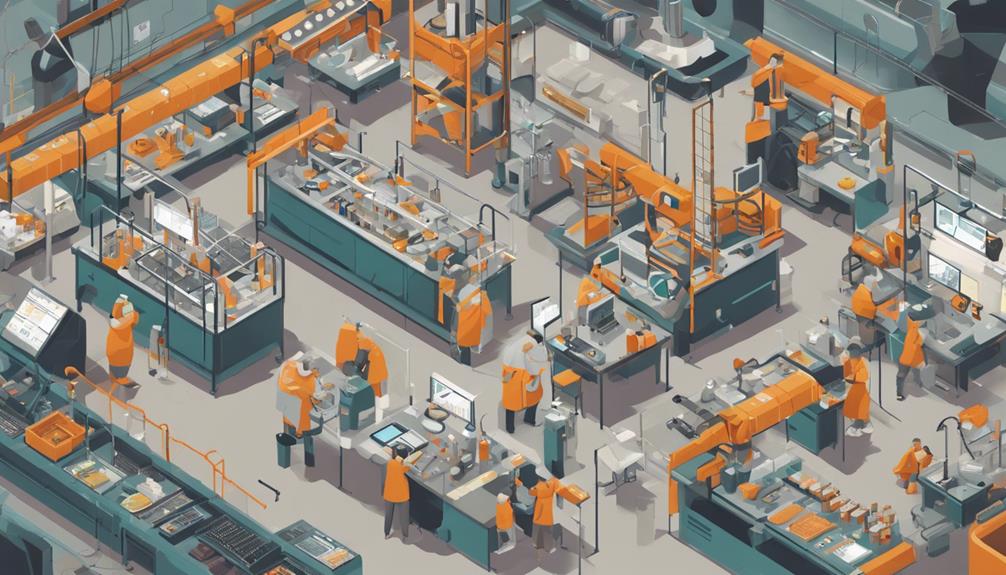
A thorough quality control checklist is essential for assembly lines, as it enables manufacturers to systematically evaluate and refine their production processes, thereby guaranteeing the consistent delivery of high-quality electronic devices. This extensive checklist facilitates the identification of defects, maintains consistency, and secures compliance throughout the production process.
| Quality Control Aspect | Inspection Points | Benefits |
|---|---|---|
| Dimensional Accuracy | Measurement verification | Reduces defects, secures compliance |
| Visual Inspections | Visual examination of components | Identifies defects, improves product quality |
| Functional Testing | Performance verification | Secures product functionality, improves reliability |
| Cleanliness Control | Cleanliness standards verification | Prevents contamination, secures product reliability |
Raw Materials and Equipment Checks

Reliably sourcing high-quality raw materials and ensuring equipment functionality are vital components of an effective assembly line quality control process. To achieve this, a thorough raw materials and equipment checks process is essential. This begins with an incoming inspection to verify that raw materials meet specified standards before production commences.
Regular equipment calibration is also important to guarantee accurate measurements and consistent performance. Moreover, material specifications must be verified to ensure compliance with quality requirements. Equipment maintenance needs should be inspected and addressed promptly to prevent breakdowns and ensure smooth operations.
Additionally, storage conditions must be monitored to prevent material degradation and maintain quality standards. By implementing these checks, manufacturers can prevent defects, reduce waste, and ensure compliance with quality requirements. A robust quality control process relies on the meticulous execution of these raw materials and equipment checks to deliver high-quality products that meet customer expectations.
PCB Assembly Line Quality Control

What specific standards and functionality requirements must printed circuit boards meet to pass quality control checks on the assembly line?
To guarantee the highest level of quality, PCB assembly lines must adhere to stringent quality control measures. This involves inspecting and testing printed circuit boards to ensure they meet specific standards and functionality requirements. Effective quality control checks help identify defects early in the manufacturing process, preventing faulty products from reaching customers and reducing rework, scrap, and production delays.
Inspection of solder joints, component placement, and electrical connections are vital quality control steps in PCB assembly line processes. By implementing stringent quality control practices, manufacturers can enhance product reliability, customer satisfaction, and brand reputation in the electronics industry.
Implementing Quality Control Measures
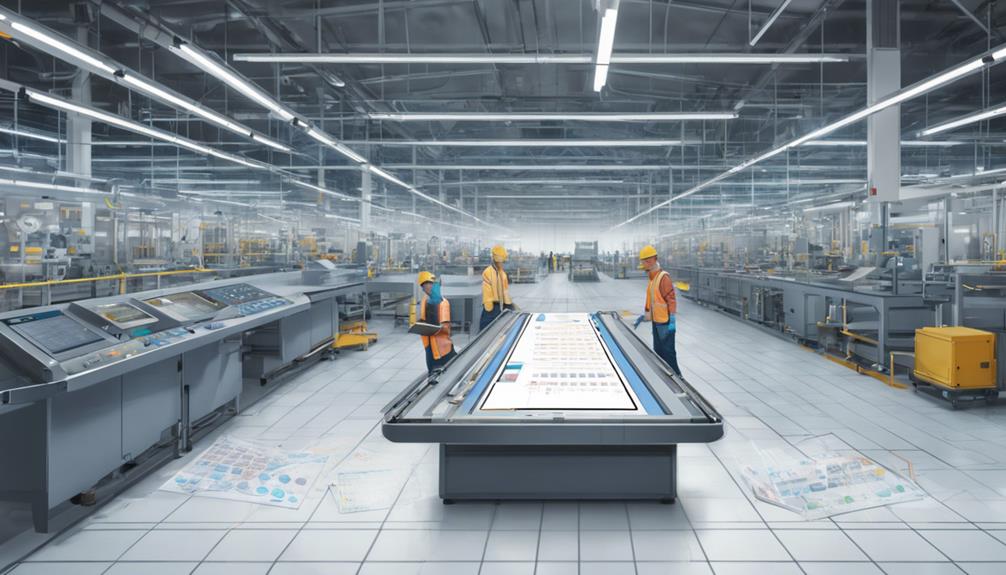
Implementing quality control measures is essential to detecting defects early in the production process, thereby preventing faulty products from reaching consumers and reducing associated costs. This proactive approach guarantees that manufacturing processes meet regulatory requirements and customer expectations, thereby enhancing product reliability and brand reputation.
To achieve effective quality control, manufacturers should:
- Establish strict standards for product quality based on industry regulations and customer expectations
- Conduct regular thorough inspections of materials, components, and final products to ensure they meet defined quality criteria
- Implement a defect identification process to detect and address defects early in production
- Train production staff on quality control procedures to ensure consistency and compliance
- Continuously monitor and evaluate quality control measures to identify areas for improvement and optimize cost savings
Monitoring and Correcting Defects
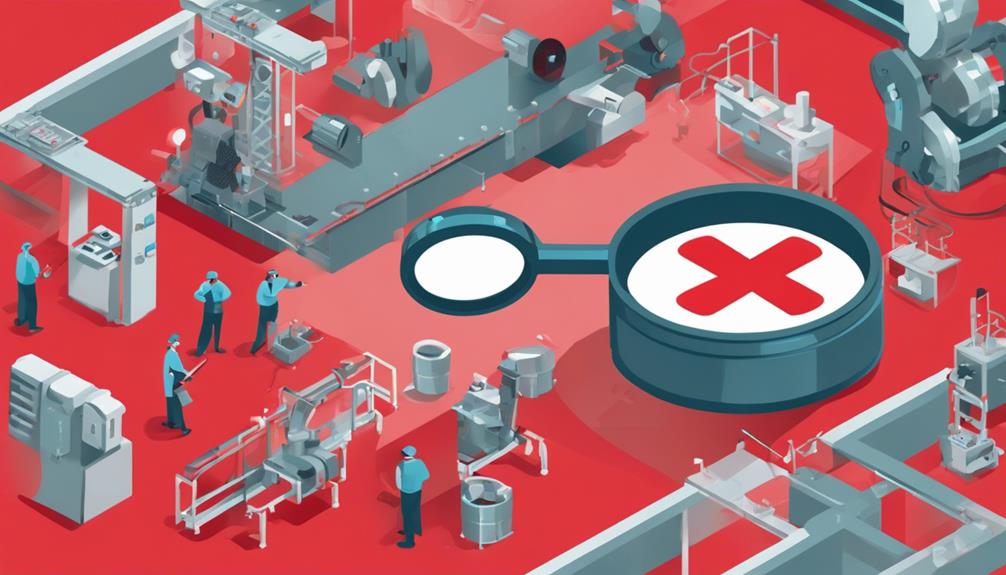
As manufacturers endeavor to maintain the highest quality standards, monitoring and correcting defects in real-time is essential to preventing production delays and ensuring overall product excellence. This involves implementing a robust quality control system that enables real-time defect tracking, swift corrective actions, and process improvement. By utilizing advanced quality control tools and technology, manufacturers can identify defect trends and patterns, and implement corrective actions to prevent further production delays.
| Defect Monitoring | Corrective Actions |
|---|---|
| Real-time defect tracking | Swift implementation of corrective actions |
| Defect identification and analysis | Process improvement and refinement |
| Performance metrics review | Continuous quality improvement |
Regular training of assembly line workers on defect identification and resolution is also critical to enhance overall production efficiency. By reviewing defect data and performance metrics regularly, manufacturers can promote continuous quality improvement on the assembly line. This proactive approach to defect monitoring and correction enables manufacturers to maintain high-quality products, reduce production delays, and ultimately, improve their bottom line.
Continuous Improvement and Refining
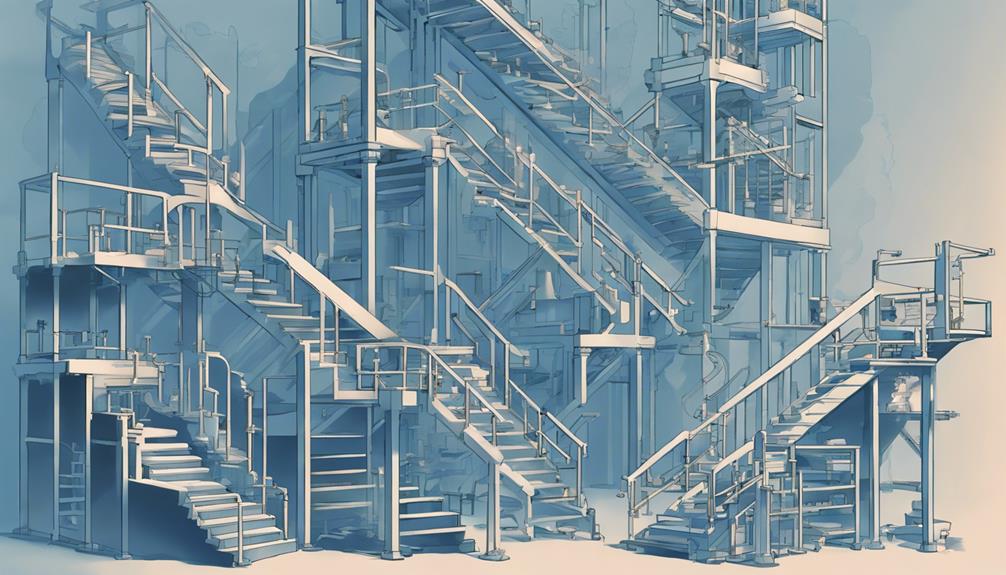
To achieve sustainable efficiency gains on the assembly line, it is essential to identify areas for change and optimize current processes. By analyzing data trends and feedback, manufacturers can pinpoint opportunities for refinement and implement targeted improvements.
Identify Areas for Change
Continuous refinement of assembly line processes is crucial for identifying areas that require adjustments, thereby driving efficiency, reducing defects, and enhancing overall product quality. By regularly reviewing and updating the assembly line checklist, manufacturers can pinpoint opportunities for improvement, leading to increased efficiency and reduced defects. This process of continuous improvement allows companies to stay competitive, meet customer demands, and drive profitability.
To identify areas for change, manufacturers should:
- Analyze feedback and data to identify trends and patterns
- Review the assembly line checklist to pinpoint areas for refinement
- Implement changes based on data analysis and feedback
- Focus on refining processes to enhance product quality
- Regularly assess and adjust the manufacturing process to ensure ongoing improvement
Optimize Current Processes
Improvement of existing processes is pivotal to harnessing the full potential of an assembly line, as even minute adjustments can have a profound impact on productivity, quality, and ultimately, profitability. By refining assembly line processes, manufacturers can reduce defects, errors, and rework, resulting in improved product quality and increased customer satisfaction.
To optimize current processes, it is essential to implement feedback mechanisms for process refinement. This can be achieved through regular review and update of assembly line procedures. By doing so, manufacturers can identify areas for improvement and optimize workflow, leading to cost savings and increased competitiveness in the market.
| Benefits of Process Refinement | Impact on Assembly Line |
|---|---|
| Continuous Improvement | 10-20% increase in sales revenue |
| Reduced Defects and Errors | Improved product quality and customer satisfaction |
| Feedback Mechanisms | Enhanced efficiency and productivity |
| Regular Review and Update | Identification of areas for improvement and optimized workflow |
| Process Refinement | Cost savings and increased competitiveness |
How Can an Assembly Line Checklist Impact the Cost of PCB Assembly Line Production?
An assembly line checklist plays a crucial role in controlling the cost of PCB assembly. By ensuring that each step in the production process is completed accurately and efficiently, the checklist helps to minimize errors and rework, ultimately reducing the overall cost of PCB assembly production.
Optimizing Production With Quality Control
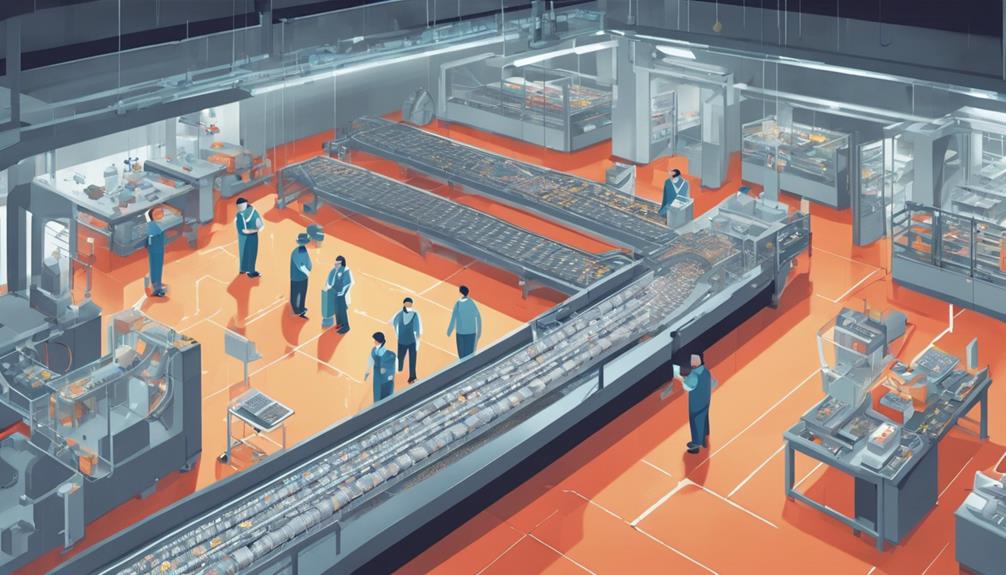
To optimize production with quality control, it is essential to implement process standardization methods that guarantee consistency and repeatability in manufacturing processes.
Evaluating quality metrics is also important in identifying areas for improvement, while defect reduction strategies can help minimize errors and rework.
Process Standardization Methods
By establishing standardized procedures for each step in the assembly line, manufacturers can greatly reduce variability, minimize errors, and optimize production efficiency. Process standardization methods guarantee consistency and quality, leading to higher quality products that meet customer expectations and increase profitability.
Some key benefits of process standardization include:
- Facilitating training of new employees and streamlining operations
- Enabling easier identification of issues for continuous improvement
- Maintaining product integrity and reducing waste
- Enhancing overall manufacturing performance and quality assurance
- Improving quality control and reducing errors
Quality Metrics Evaluation
Quality metrics evaluation serves as an essential tool in the pursuit of production excellence, empowering manufacturers to pinpoint areas of inefficiency and implement targeted interventions to elevate product quality.
By tracking key performance indicators such as defect rates, rework percentages, and production cycle times, manufacturers can optimize production and enhance product quality. This rigorous evaluation process enables the identification of areas for improvement, allowing for corrective actions to be taken to reduce waste and increase efficiency.
Through quality metrics evaluation, manufacturers can meet customer expectations by ensuring consistent product quality and minimizing defects in the assembly line process. Monitoring quality metrics facilitates continuous improvement and proactive problem-solving, maintaining high standards of production.
Defect Reduction Strategies
Implementing defect reduction strategies is crucial in optimizing production, as it enables manufacturers to identify and address defects early in the production process, thereby minimizing rework and enhancing overall product quality. By integrating quality control measures into the production process, manufacturers can reduce defects, increase manufacturing efficiency, and improve product quality. This, in turn, leads to increased customer satisfaction, loyalty, and ultimately, revenue growth.
To achieve defect reduction, manufacturers can employ the following strategies:
- Conduct root cause analysis to identify the sources of defects and implement corrective actions
- Utilize thorough assembly line checklists to ensure quality control measures are in place
- Implement continuous improvement processes to monitor and address defects in real-time
- Train production staff on quality control best practices to enhance product quality
- Analyze product defects to identify trends and areas for improvement in the production process
Frequently Asked Questions
What Is a QC Checklist?
A Quality Control (QC) checklist is a meticulous document that verifies product quality and compliance with industry standards throughout the assembly line process.
It comprises inspection points to identify defects, maintain consistency, and reduce errors, ensuring high-quality production outcomes.
How Do You Create a Quality Checklist?
As the ancient Greek philosopher, Aristotle, once said, 'We are what we repeatedly do. Excellence, then, is not an act, but a habit.'
When creating a quality checklist, excellence is not an option, it's a necessity. Start by identifying critical control points in the production process. Determine the key performance indicators (KPIs) and critical-to-quality (CTQ) characteristics.
Then, establish clear and concise inspection points, ensuring dimensional accuracy, visual inspection, and functional testing.
What Will Be a Checklist for a Manufacturing Process Design?
A manufacturing process design checklist should encompass essential elements to guarantee quality and consistency. It should outline production stages, material specifications, and equipment requirements.
Quality control measures, calibration standards, and maintenance schedules must also be detailed. Additionally, the checklist should cover quality assurance processes, documentation standards, and personnel responsibilities.
This thorough approach guarantees high-quality output, error detection, and compliance with industry standards.
What Is the Purpose of QA Checklist?
The primary purpose of a QA checklist is to make sure that products meet predetermined quality standards and specifications during the manufacturing process.
It serves as a systematic approach to detect defects, ensure consistency, and prevent errors in production.

